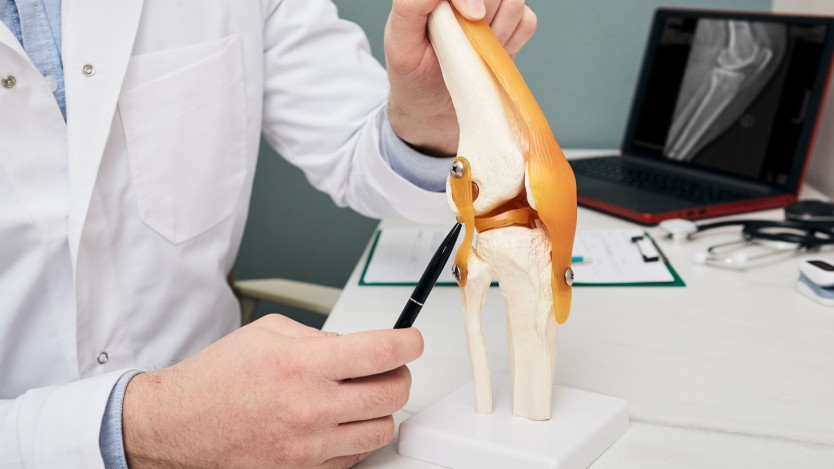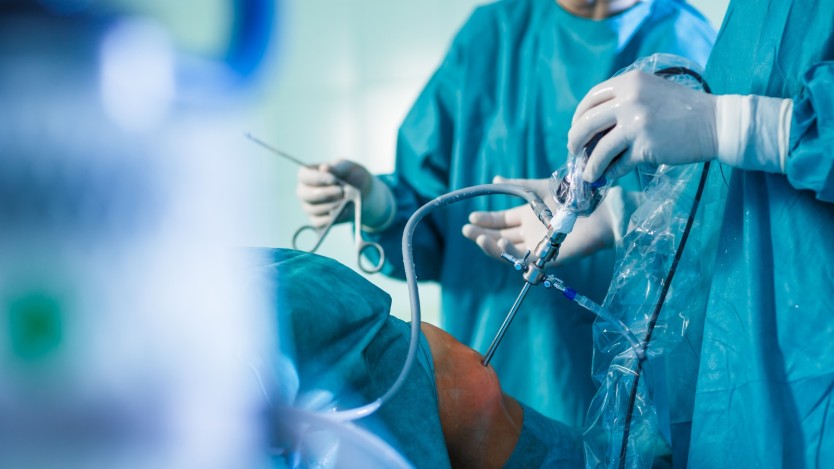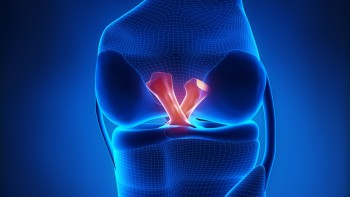Posterior Cruciate Ligament (PCL) tear: When should surgery be performed and are there other treatments?

- What is the posterior cruciate ligament (PCL) and where is it located?
- How does a posterior cruciate ligament (PCL) tear occur?
- When is it always necessary to operate on a ruptured posterior cruciate ligament (PCL)?
- Posterior cruciate ligament (PCL) surgery: step by step
- Recovery from posterior cruciate ligament reconstruction surgery
- There are several types of ligaments in the knee, one of them being the posterior cruciate ligament, which is considered the strongest.
- Ruptures are rare, especially compared to the ACL, but partial or complete ruptures can still occur.
- In many cases conservative treatment can be chosen, but in others ligament reconstruction surgery is the best option.
What is the posterior cruciate ligament (PCL) and where is it located?
A ligament is a ribbon of dense fibrous tissue, inserted into bones or cartilage, that serves as a means of joint attachment.
In the case of the posterior cruciate ligament, it is considered the strongest ligament of the knee and is located at the back of the joint.

Do you need cruciate ligaments surgery?
Request a free and immediate appointment with our specialists in Traumatology
It is inserted behind the tibial spine and the internal condyle, i.e. it connects the tibia (shin bone) to the femur (thigh bone) at the back of the knee.
Its function is to support the tibia and prevent it from rolling behind the femur, and together with the other ligaments of the joint (the internal and external lateral ligaments as well as the anterior cruciate ligament) it serves to maintain the stability of the knee.
However, although it is considered to be the strongest ligament in the knee, injuries, including complete ruptures, also occur in the knee. We discuss this in the following section.
How does a posterior cruciate ligament (PCL) tear occur?
It is estimated that between 5% and 20% of knee ligament injuries involve the posterior cruciate ligament. In the case of a rupture of the posterior cruciate ligament it can be:
- Partial rupture of the posterior cruciate ligament: Only part of the ligament is torn.
- Total rupture: In this case, the ligament is torn in two.
Rupture of the posterior cruciate ligament usually occurs as a result of a serious knee injury and is often accompanied by other damage to the joint, such as ruptured ligaments, nerve and blood vessel injuries, and even bone injuries.

The most common situations in which posterior cruciate ligament rupture can occur are:
- A hard blow to the front of the knee (hitting the dashboard in a car accident).
- Falling hard with the knee bent
- Hyperflexion of the knee (bending the knee too far backwards)
- Falling badly when jumping
When a posterior cruciate ligament (PCL) rupture occurs, the person feels severe pain and swelling in the knee. This pain usually subsides after 2 to 3 days. It can also feel like the knee is giving way as one of the elements of stability is lost.
Although it is possible to rupture this ligament, as mentioned above, it is not always necessary to operate, especially in cases where the rupture is not complete. This information is explained in more detail below.
When is it always necessary to operate on a ruptured posterior cruciate ligament (PCL)?
As we have already indicated, when the posterior cruciate ligament ruptures, the first thing that occurs is pain and inflammation of the knee.
Under these conditions, it is difficult for the traumatologist to carry out a proper examination of the knee, and it is advisable to return to the doctor 2 weeks after the injury to carry out the examination and the relevant diagnostic tests.
Initial treatment of PCL rupture
At this time, the initial treatment of a posterior cruciate ligament (PCL) tear is usually advised:
- Immobilise the knee.
- Apply cold to the knee swelling.
- Take painkillers.
- Sometimes, puncture the knee to remove the effusion, always done by medical personnel.
Depending on the results of the diagnostic tests performed by the orthopaedic surgeon, the posterior cruciate ligament (PCL) injury can be classified as follows:
- Grade I: When the backward displacement of the tibia is less than 5 mm.
- Grade II: The tibial displacement is between 5- 10 mm.
- Grade III: If the displacement is greater than 10 mm.
- Grade IV: More lesions are associated
Once the injury has been diagnosed by the orthopaedic surgeon, the latter will opt for one type of treatment or another, which may be conservative or surgical:
Conservative treatment of PCL rupture
When it is an isolated injury of the posterior cruciate ligament without total rupture (grade I and grade II), and the patient's characteristics allow it, the usual treatment is conservative, not surgical.
The posterior cruciate ligament is self-repairing and can be recovered with:
- Rest for 4 to 6 weeks
- Rehabilitation (6 months or more) to regain knee joint function. It is very important to carry out rehabilitation with great intensity.
During the rehabilitation period, the patient should use crutches for walking to avoid pain. In some cases, the use of knee protectors may be advised to allow flexion of the joint during rehabilitation.
On the other hand, in the event that the rupture or the patient's day-to-day life does not allow conservative treatment and the Specialist in Traumatology and Orthopaedic Surgery so decides, the most advisable option will be the cruciate ligament reconstruction surgery, usually performed by arthroscopy.
Surgical treatment of posterior cruciate ligament tear
If knee stability cannot be improved, in case of chronic injury (injury sustained more than 6 months ago) or in case of complete rupture of the posterior cruciate ligament or in association with other knee injuries, surgical treatment is indicated.
This posterior cruciate ligament reconstruction procedure is performed by arthroscopy, which is a minimally invasive surgical technique.
A complete rupture of the posterior cruciate ligament with instability in the knee can quickly lead to osteoarthritis of the kneecap and more pain, which may eventually result in the patient's knee having to be operated on as a person with osteoarthritis, in which case a knee prosthesis is necessary.
When considering a patient for posterior cruciate ligament rupture surgery, the orthopaedic surgeon usually takes into account:
- The physical activity carried out: A professional athlete will undergo surgery in most cases, but a person over 50 years of age who does sport occasionally may not undergo surgery.
- When the symptoms of instability in the knee do not allow normal activities, it is advisable to operate to recover the quality of life.
- If there are other associated injuries to the joint; especially when the so-called triad injury (rupture of the cruciate ligament together with the rupture of the internal collateral ligament and the meniscus) has occurred, surgery should be performed.

Do you need cruciate ligaments surgery?
Request a free and immediate appointment with our specialists in Traumatology
Posterior cruciate ligament (PCL) surgery: step by step
Based on the results of the diagnostic tests and the patient's characteristics, the doctor will determine whether or not the patient should undergo posterior cruciate ligament surgery.
If surgery is chosen, the knee arthroscopy technique is usually used for posterior cruciate ligament reconstruction.
This involves replacing the torn posterior cruciate ligament with a new one, either from the patient himself (autograft using a tendon) or from a donor bank (allograft), although the latter is not commonly performed nowadays.

It is a minimally invasive surgery, performed under general or regional anaesthesia.
It lasts between 30 and 90 minutes (depending on the severity of the injury) and usually requires a 2-day hospital stay.
Before knee arthroscopy is performed, the patient undergoes a pre-anaesthesia study to see if he or she is fit enough to undergo the operation.
When the patient is given the go-ahead for surgery, the whole process will begin.
Admission to hospital and surgery
On the day chosen for the surgery, the patient will go to the hospital (in the case of Operarme one of our personal patient care advisors will indicate all the steps to follow) and will go to admission.
You will then be taken to an area where you will wait briefly to be called for surgery. Once inside, you will be given your operating clothes and then you will enter the operating theatre where the surgeon, the anaesthetist and 1 or 2 assistants will be waiting for you to assist in the surgery.
After this, the posterior cruciate ligament reconstruction surgery with arthroscopy will begin:
- The patient is placed on the stretcher and anaesthesia is administered.
- 3-4 small incisions are made on both sides of the knee. The instruments necessary for the operation are introduced through these incisions.
- The arthroscope is introduced, which consists of a tube with a mini camera with light, connected by fibre optics to a monitor, in which the doctor can see the inside of the knee without having to open it.
- The torn ligament is removed.
- Tunnels are made in the bone to place the new ligament in the same place where the old one was. These tunnels will be filled as it heals, and the new ligament will be fixed and secured.
- The new ligament is secured with screws or other elements to keep it in place.
- When the process is complete, the incisions made are sutured and the knee is gently bandaged.
Recovery from posterior cruciate ligament reconstruction surgery
Hospitalisation is minimal (2 days). The patient usually goes home with crutches to avoid putting weight on the operated knee and an articulated knee brace, which will take 4 to 6 weeks. In any case, it is important to start walking as soon as possible, as it helps recovery, although without forcing weight or excessive flexion on the knee.
After 10 days, the stitches are removed from the incisions made in the knee, and rehabilitation will begin as soon as the doctor indicates it, so that muscle atrophy does not occur and normal mobility can be restored as soon as possible.

If rehabilitation is carried out correctly, you will be able to walk between the first and fourth week, the movement and strength of the knee is usually recovered between 2 and 6 months. As for sporting activity, recovery will take between 4 and 6 months depending on how strict you have been in your rehabilitation.
The outcome of a good recovery from posterior cruciate ligament injury surgery depends very much on the ability to adhere strictly to the rehabilitation programme, as this is the most important thing.
In case you are thinking of having a private posterior cruciate ligament reconstruction surgery, remember that you can request a free assessment consultation with one of our specialists in Orthopaedic Surgery and Traumatology below:

Do you need cruciate ligaments surgery?
Request a free and immediate appointment with our specialists in Traumatology
Medical disclaimer: All the published content in Operarme is intended to disseminate reliable medical information to the general public, and is reviewed by healthcare professionals. In any case should this information be used to perform a diagnosis, indicate a treatment, or replace the medical assessment of a professional in a face to face consultation. Find more information in the links below:



